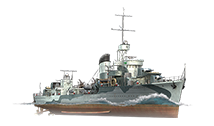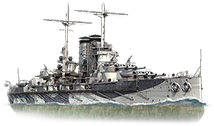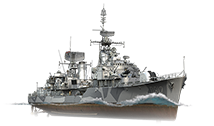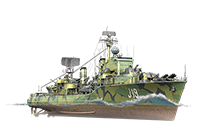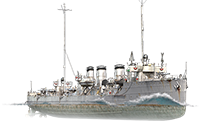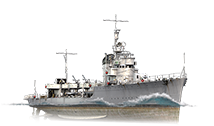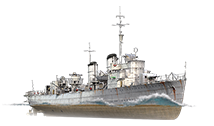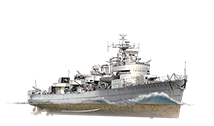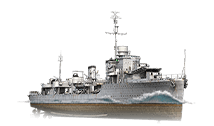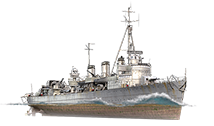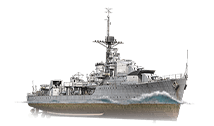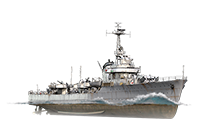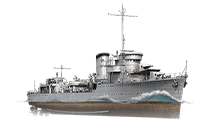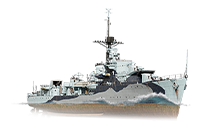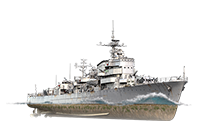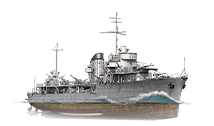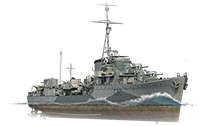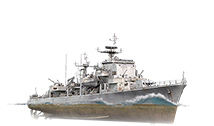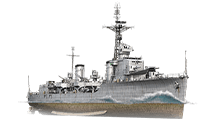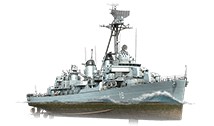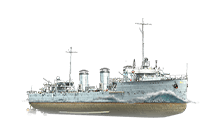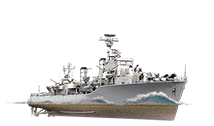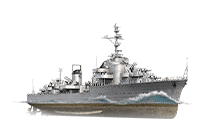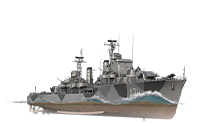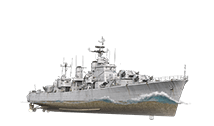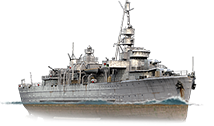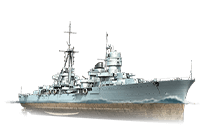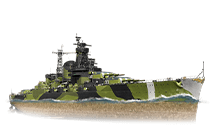Ships of Europe
| Revision as of 02:03, 21 April 2020 Information on the web | Revision as of 18:19, 26 April 2020 references | |||
3 intermediate revisions by 2 users not shown | ||||
| Line 5: | Line 5: | |||
| [[File:Wows flag Europe.png|frameless|left|link=]]The Pan-Europe faction does not cover a specific nation, but includes ships from various nations within the European region. Ships from these navies are currently represented in World of Warships: Sweden, Poland, Austria-Hungary, and the Netherlands. In-game, each ship can fly the individual jack of their respective navy (as shown below) or the Pan-European flag (as shown on the left). | [[File:Wows flag Europe.png|frameless|left|link=]]The Pan-Europe faction does not cover a specific nation, but includes ships from various nations within the European region. Ships from these navies are currently represented in World of Warships: Sweden, Poland, Austria-Hungary, and the Netherlands. In-game, each ship can fly the individual jack of their respective navy (as shown below) or the Pan-European flag (as shown on the left). | |||
| ---- | ---- | |||
| ? | [[File:Poland-2.png|68px|frameless|left|link=]][[Image:Ship_PWSD501_Blyskawica.png|frame|right|link=Ship:Blyskawica|ORP ''Błyskawica'', Tier VII destroyer]]Political enthusiasm for a fully fledged '''Polish Navy''' (''Marynarka Wojenna'') had always been tepid; a relatively short coastline and access to the Atlantic restricted by its Scandinavian neighbors led the Polish leadership to relegate what little naval assets Poland had to river and coastal defense. The first attempt at a proper navy, the Polish–Lithuanian Commonwealth Navy, achieved great success against Sweden in the Polish-Swedish War (1600-1629), but was completely destroyed by Denmark in 1637. No serious attempts at rebuilding the navy were made throughout the rest of the Commonwealth's existence, and its dissolution at the Partitions of Poland in the late 18th century meant that any hopes of doing so had all but vanished. It was Józef Piłsudski, then-Commander in Chief of the Polish Armed Forces, who founded what is now known as the modern Polish Navy on 28 November 1918, nearly three centuries after its destruction. Once again, her primary purpose was to protect the Polish coastline against various threats, with an emphasis on fast submarines, powerful destroyers, and judicious use of mines. However, the Great Depression limited the Polish Navy's major combat vessels to a mere four destroyers, five submarines, and the minelayer ORP ''Gryf'' at the onset of World War II. | + | [[File:Poland-2.png|68px|frameless|left|link=]][[Image:Ship_PWSD501_Blyskawica.png|frame|right|link=Ship:Blyskawica|ORP ''Błyskawica'', Tier VII destroyer]]Political enthusiasm for a fully fledged '''Polish Navy''' (''Marynarka Wojenna'')<ref> | |
| + | [https://en.wikipedia.org/wiki/Polish_Navy Polish Navy (Wikipedia)] and [https://en.wikipedia.org/wiki/List_of_ships_of_the_Polish_Navy Ships of the Polish Navy (Wikipedia)]</ref> had always been tepid; a relatively short coastline and access to the Atlantic restricted by its Scandinavian neighbors led the Polish leadership to relegate what little naval assets Poland had to river and coastal defense. The first attempt at a proper navy, the Polish–Lithuanian Commonwealth Navy, achieved great success against Sweden in the Polish-Swedish War (1600-1629), but was completely destroyed by Denmark in 1637. No serious attempts at rebuilding the navy were made throughout the rest of the Commonwealth's existence, and its dissolution at the Partitions of Poland in the late 18th century meant that any hopes of doing so had all but vanished. It was Józef Piłsudski, then-Commander in Chief of the Polish Armed Forces, who founded what is now known as the modern Polish Navy on 28 November 1918, nearly three centuries after its destruction. Once again, her primary purpose was to protect the Polish coastline against various threats, with an emphasis on fast submarines, powerful destroyers, and judicious use of mines. However, the Great Depression limited the Polish Navy's major combat vessels to a mere four destroyers, five submarines, and the minelayer ORP ''Gryf'' at the onset of World War II. | |||
| Initially deciding on a strategy of harassment and indirect engagement, Polish naval command realized that the small, mostly landlocked Baltic Sea was well within range of the [[Ship:Ships_of_Germany|Kriegsmarine]] ''and'' the Luftwaffe, and that any ship would be quickly found and sent to the bottom if they were to remain there. Thus on 29 August 1939, the Peking Plan was executed with assistance from the [[Ship:Ships_of_U.K.|Royal Navy]], evacuating the destroyers stationed in the Baltic — ORP ''Burza'', ORP ''[[Błyskawica]]'' and ORP ''Grom'' — to the naval base at Leith, Scotland, just 3 days before the invasion of Poland and the outbreak of war. Initially seen as "abandoning" their country, the operation was a wise decision by the Polish naval command, preserving the destroyers to allow them to take part in the defense of Norway, Operation Dynamo, the Battle of the Atlantic, and dozens of escort and convoy missions. Moreover, supplemented by ships from the Royal Navy, the Polish Navy in exile as a whole also participated in major engagements such as the sinking of ''[[Bismarck]]'', Operation Jubilee, and Operation Overlord. On the other hand, ORP ''Gryf'' and ORP ''Wicher'', who had remained behind in the Baltic Sea, were sunk within the first three days of the war. | Initially deciding on a strategy of harassment and indirect engagement, Polish naval command realized that the small, mostly landlocked Baltic Sea was well within range of the [[Ship:Ships_of_Germany|Kriegsmarine]] ''and'' the Luftwaffe, and that any ship would be quickly found and sent to the bottom if they were to remain there. Thus on 29 August 1939, the Peking Plan was executed with assistance from the [[Ship:Ships_of_U.K.|Royal Navy]], evacuating the destroyers stationed in the Baltic — ORP ''Burza'', ORP ''[[Błyskawica]]'' and ORP ''Grom'' — to the naval base at Leith, Scotland, just 3 days before the invasion of Poland and the outbreak of war. Initially seen as "abandoning" their country, the operation was a wise decision by the Polish naval command, preserving the destroyers to allow them to take part in the defense of Norway, Operation Dynamo, the Battle of the Atlantic, and dozens of escort and convoy missions. Moreover, supplemented by ships from the Royal Navy, the Polish Navy in exile as a whole also participated in major engagements such as the sinking of ''[[Bismarck]]'', Operation Jubilee, and Operation Overlord. On the other hand, ORP ''Gryf'' and ORP ''Wicher'', who had remained behind in the Baltic Sea, were sunk within the first three days of the war. | |||
| ? | Poland's years as a Warsaw Pact country did not diminish her need for a naval presence in the Baltic Sea, and that remained the focus of her navy for a half century following the close of World War II. Joining the North Atlantic Treaty Organization (NATO) on 29 March 1999 forced a change in that mindset; the Polish Navy of the 21st century has re-focused on greater levels of international cooperation and sea-going patrols in cooperation with her new NATO partners, developing a specialization in sub-surface combat. | + | Poland's years as a Warsaw Pact country did not diminish her need for a naval presence in the Baltic Sea, and that remained the focus of her navy for a half century following the close of World War II. Joining the North Atlantic Treaty Organization (NATO) on 29 March 1999 forced a change in that mindset; the Polish Navy of the 21st century has re-focused on greater levels of international cooperation and sea-going patrols in cooperation with her new NATO partners, developing a specialization in sub-surface combat. | |
| ? | + | |||
| ? | + | |||
| ? | + | |||
| ? | + | |||
| ---- | ---- | |||
| [[File:Austria_hungary.png|68px|frameless|left|link=]][[Image:Ship_PWSB504_Viribus_Unitis.png|frame|right|link=Ship:Viribus Unitis|SMS''Viribus Unitis'', Tier V battleship]] '''Austro-Hungarian Navy''' | [[File:Austria_hungary.png|68px|frameless|left|link=]][[Image:Ship_PWSB504_Viribus_Unitis.png|frame|right|link=Ship:Viribus Unitis|SMS''Viribus Unitis'', Tier V battleship]] '''Austro-Hungarian Navy''' | |||
| ? | Austria first gained access to the ocean in 1382, yet it would take over one hundred years for armed warships to be flying the Austrian colors starting in very small numbers in 1528. This small group mainly served as coastal defense, and was only under a very local command. It was only in 1797 that Austria truly started to maintain a navy, when Venice became a part of Austria and the Venecian fleet would become the Austrian fleet. This however only lasted for a mere 50 years before the ''Guerre d'indipendenza italiane'', the Italian war for independence, broke out, in which the majority of the crews of Italian origin would turn against the Austrian rule. Having lost almost their entire Naval power, it became clear that Austrian interests on the ocean could only be secured by a proper Austrian Navy. Emperor ''Franz Joseph'' drew the consequences and began laying the foundation of a full Austrian Navy. With the inclusion of Hungary in 1867 the navy became the '''Austro-Hungarian Navy'''. Despite the everlasting budget issues, the Austro-Hungarian Navy would become one of the larger navies and would follow the latest naval trends, or even set one themselves like with the construction of the first torpedo. | + | Austria first gained access to the ocean in 1382, yet it would take over one hundred years for armed warships to be flying the Austrian colors starting in very small numbers in 1528. This small group mainly served as coastal defense, and was only under a very local command. It was only in 1797 that Austria truly started to maintain a navy, when Venice became a part of Austria and the Venecian fleet would become the Austrian fleet. This however only lasted for a mere 50 years before the ''Guerre d'indipendenza italiane'', the Italian war for independence, broke out, in which the majority of the crews of Italian origin would turn against the Austrian rule. Having lost almost their entire Naval power, it became clear that Austrian interests on the ocean could only be secured by a proper Austrian Navy. Emperor ''Franz Joseph'' drew the consequences and began laying the foundation of a full Austrian Navy. With the inclusion of Hungary in 1867 the navy became the '''Austro-Hungarian Navy'''<ref>[https://en.wikipedia.org/wiki/Austro-Hungarian_Navy Austro-Hungarian Navy (Wikipedia)] and [https://en.wikipedia.org/wiki/List_of_ships_of_Austria-Hungary Ships of Austria-Hungary (Wikipedia)]</ref>. Despite the everlasting budget issues, the Austro-Hungarian Navy would become one of the larger navies and would follow the latest naval trends, or even set one themselves like with the construction of the first torpedo. | |
| ? | During the first world war the Austro-Hungarian Navy was blocked the access to the Mediterranean Sea by Italian, French and British forces, and would be delegated to a Fleet-In-Being. However the smaller forces would continuously be active in the Mediterranean, in particular submarines which would over the course of the war sink 196,000 GRT with a further 41,000 GRT being possibly sunk. On top of that numerous warships would be crippled and sunk by smaller forces. The only vessel that would see action outside the Mediterranean would be the cruiser ''Kaiserin Elisabeth'', which would otherwise become known as the first target of a ship-launched aircraft. | + | During the first world war the Austro-Hungarian Navy was blocked the access to the Mediterranean Sea by Italian, French and British forces, and would be delegated to a Fleet-In-Being. However the smaller forces would continuously be active in the Mediterranean, in particular submarines<ref>[https://en.wikipedia.org/wiki/List_of_Austro-Hungarian_U-boats Austro-Hungarian U-boats (Wikipedia)]</ref> which would over the course of the war sink 196,000 GRT with a further 41,000 GRT being possibly sunk. On top of that numerous warships would be crippled and sunk by smaller forces. The only vessel that would see action outside the Mediterranean would be the cruiser<ref>[https://en.wikipedia.org/wiki/List_of_cruisers_of_Austria-Hungary Cruisers of Austria-Hungary (Wikipedia)]</ref> ''Kaiserin Elisabeth'', which would otherwise become known as the first target of a ship-launched aircraft. | |
| ? | The end of the Great War in 1918 marked the end of the Austro-Hungarian empire, and as such the end of the Austro-Hungarian Navy. The remaining vessels would become parts of other navies, or in the case of [[Viribus Unitis]] get sunk by Italian divers before they could be redistributed. Austria became a nation in central Europe with no access to the ocean, rendering the need for a large navy impractical. | + | The end of the Great War in 1918 marked the end of the Austro-Hungarian empire, and as such the end of the Austro-Hungarian Navy. The remaining vessels would become parts of other navies, or in the case of the battleship<ref>[https://en.wikipedia.org/wiki/List_of_battleships_of_Austria-Hungary Battleships of Austria-Hungary (Wikipedia)]</ref> [[Viribus Unitis]] get sunk by Italian divers before they could be redistributed. Austria became a nation in central Europe with no access to the ocean, rendering the need for a large navy impractical. | |
| ? | + | |||
| ? | + | |||
| ? | + | |||
| ? | + | |||
| ? | + | |||
| ? | + | |||
| ? | + | |||
| ---- | ---- | |||
| [[File:Netherlands-2.png|68px|frameless|left|link=]][[Image:Ship_PWSD510_Friesland.png|frame|right|link=Ship:Friesland|HNLMS ''Friesland'', Tier IX destroyer]] '''Royal Netherlands Navy (RNLN)''' (''Koninklijke Marine'') | [[File:Netherlands-2.png|68px|frameless|left|link=]][[Image:Ship_PWSD510_Friesland.png|frame|right|link=Ship:Friesland|HNLMS ''Friesland'', Tier IX destroyer]] '''Royal Netherlands Navy (RNLN)''' (''Koninklijke Marine'') | |||
| ? | The Royal Netherlands Navy's origins date back to the Eighty Years' War (1568–1648), the war of independence from the House of Habsburg who ruled over the Habsburg Netherlands. | + | The Royal Netherlands Navy's<ref>[https://en.wikipedia.org/wiki/Royal_Netherlands_Navy Royal Netherlands Navy (Wikipedia)]</ref> origins date back to the Eighty Years' War (1568–1648), the war of independence from the House of Habsburg who ruled over the Habsburg Netherlands. | |
| During the 17th century the navy of the Dutch Republic (1581–1795) was one of the most powerful naval forces in the world and played an active role in wars against England, France, Spain and several other European powers. The navy of the later Batavian Republic (1795–1806) and Kingdom of Holland (1806–1810) played an active role in the Napoleonic Wars, though mostly dominated by French interests. After the establishment of the modern Kingdom of the Netherlands (founded 1815) it served an important role in protecting Dutch colonial rule, especially in Southeast Asia, and would play a minor role in World War II, especially against the Imperial Japanese Navy. | During the 17th century the navy of the Dutch Republic (1581–1795) was one of the most powerful naval forces in the world and played an active role in wars against England, France, Spain and several other European powers. The navy of the later Batavian Republic (1795–1806) and Kingdom of Holland (1806–1810) played an active role in the Napoleonic Wars, though mostly dominated by French interests. After the establishment of the modern Kingdom of the Netherlands (founded 1815) it served an important role in protecting Dutch colonial rule, especially in Southeast Asia, and would play a minor role in World War II, especially against the Imperial Japanese Navy. | |||
| ? | ||||
| ? | ||||
| ? | ||||
| ? | ||||
| ? | ||||
| ? | ||||
| ? | ||||
| ---- | ---- | |||
| + | [[File:Sweden flag.png|68px|frameless|left|link=]][[Image:Ship_PWSD610_Smaland.png|frame|right|link=Ship:Smaland|HswMS ''Småland'', Tier X destroyer]] | |||
| + | '''Royal Swedish Navy''' (''Svenska marinen'') | |||
| + | The Royal Swedish Navy<ref>[https://en.wikipedia.org/wiki/Swedish_Navy Swedish Navy (Wikipedia)] and [//navypedia.org/ships/sweden/sw_index.htm Ships of the Swedish Navy (Navypedia)]</ref> has officially existed since the 7th of June, 1522. Formed in the middle of the Swedish War of Liberation (1521-1523), where Sweden fought for her independence from the Kalmar Union, the Swedish Navy took part in numerous wars in the ensuring centuries. However, Sweden's armed neutrality has lasted from the end of the Swedish-Norwegian war (1814) to the present day, though Swedish forces have become intervened in other conflicts. Swedish ships use the prefix HMS (Hans/Hennes majestäts skepp, or His/Her Majesties' ship), but in English they are normally given the prefix HswMS, to avoid confusion with the [https://wiki.wargaming.net/en/Ship:Ships_of_U.K. Royal Navy]. | |||
| ? | + | Sweden's navy was the main enforcer of her neutral policies during both World Wars. While Sweden has never fielded a 'true' battleship, she has kept seaworthy coastal defense battleships since 1886. Indigenous shipbuilders built these coastal defense battleships, cruisers, and destroyers, which were in service from before the first World War until the decommissioning of the [[Halland]] in 1987. Sweden's coastal defense battleships have been cited as a reason Germany did not invade Sweden like her Scandinavian neighbors, but how much impact these ships had compared to the military, industrial, and political concessions to the Reich is debatable. | ||
| ? | + | |||
| ? | + | As the Cold War began, it was thought that large Swedish Navy ships would not survive any sort of nuclear attacks in the enclosed Baltic. Thus, construction of ships larger than frigates was stopped, with many larger ships being sold to South American nations or scrapped outright. Destroyer [[Småland]] survives as a museum ship in Gothenburg. | ||
| }} | }} | |||
| {{#vardefine:cur_nation|europe}}__NOTOC__[[Category:Ships by nation]] | {{#vardefine:cur_nation|europe}}__NOTOC__[[Category:Ships by nation]] | |||
| + | ||||
| {{#vardefine:list|{{WoWs Class||list}}}}{{#vardefine:i|0}}{{#while:|{{#if:{{#explode:{{#var:list}}|;|{{#var:i}}}}|true}}| | {{#vardefine:list|{{WoWs Class||list}}}}{{#vardefine:i|0}}{{#while:|{{#if:{{#explode:{{#var:list}}|;|{{#var:i}}}}|true}}| | |||
| {{#vardefine:cur_class|{{#explode:{{#var:list}}|;|{{#var:i}}}}}}{{#if:{{WoWs_ShipsList|{{#var:cur_nation}}|{{#var:cur_class}}|||text}}|<div class="wot-frame-1"><h2>{{WoWs Class|{{#var:cur_class}}|bm}}</h2> | {{#vardefine:cur_class|{{#explode:{{#var:list}}|;|{{#var:i}}}}}}{{#if:{{WoWs_ShipsList|{{#var:cur_nation}}|{{#var:cur_class}}|||text}}|<div class="wot-frame-1"><h2>{{WoWs Class|{{#var:cur_class}}|bm}}</h2> | |||
| {{WoWs_ShipsList|{{#var:cur_nation}}|{{#var:cur_class}}|||icons}}</div>}}{{#vardefine:i|{{#expr:{{#var:i}}+1}}}}}} | {{WoWs_ShipsList|{{#var:cur_nation}}|{{#var:cur_class}}|||icons}}</div>}}{{#vardefine:i|{{#expr:{{#var:i}}+1}}}}}} | |||
| + | ||||
| + | == Notes == | |||
| + | ||||
| + | [https://worldofwarships.com/en/news/game-guides/european-destroyers-branch-review/ European Destroyers: Branch Review - 04/08/2020 - News - World of Warships]<br /> | |||
| + | [https://www.youtube.com/watch?v=ayufyOTylOk European Destroyers. How to? - Apr 9, 2020 - World of Warships Official Channel - YouTube]<br /> | |||
| + | <br /> | |||
| + | [//www.maritiman.se/en/fleet/destroyer-smaland Destroyer Smaland (Maritiman)]<br /> | |||
| + | ||||
| + | <references /> | |||
Revision as of 18:19, 26 April 2020
(link)
European Destroyers. How to?

Initially deciding on a strategy of harassment and indirect engagement, Polish naval command realized that the small, mostly landlocked Baltic Sea was well within range of the Kriegsmarine and the Luftwaffe, and that any ship would be quickly found and sent to the bottom if they were to remain there. Thus on 29 August 1939, the Peking Plan was executed with assistance from the Royal Navy, evacuating the destroyers stationed in the Baltic — ORP Burza, ORP Błyskawica and ORP Grom — to the naval base at Leith, Scotland, just 3 days before the invasion of Poland and the outbreak of war. Initially seen as "abandoning" their country, the operation was a wise decision by the Polish naval command, preserving the destroyers to allow them to take part in the defense of Norway, Operation Dynamo, the Battle of the Atlantic, and dozens of escort and convoy missions. Moreover, supplemented by ships from the Royal Navy, the Polish Navy in exile as a whole also participated in major engagements such as the sinking of Bismarck, Operation Jubilee, and Operation Overlord. On the other hand, ORP Gryf and ORP Wicher, who had remained behind in the Baltic Sea, were sunk within the first three days of the war.
Poland's years as a Warsaw Pact country did not diminish her need for a naval presence in the Baltic Sea, and that remained the focus of her navy for a half century following the close of World War II. Joining the North Atlantic Treaty Organization (NATO) on 29 March 1999 forced a change in that mindset; the Polish Navy of the 21st century has re-focused on greater levels of international cooperation and sea-going patrols in cooperation with her new NATO partners, developing a specialization in sub-surface combat.
Austria first gained access to the ocean in 1382, yet it would take over one hundred years for armed warships to be flying the Austrian colors starting in very small numbers in 1528. This small group mainly served as coastal defense, and was only under a very local command. It was only in 1797 that Austria truly started to maintain a navy, when Venice became a part of Austria and the Venecian fleet would become the Austrian fleet. This however only lasted for a mere 50 years before the Guerre d'indipendenza italiane, the Italian war for independence, broke out, in which the majority of the crews of Italian origin would turn against the Austrian rule. Having lost almost their entire Naval power, it became clear that Austrian interests on the ocean could only be secured by a proper Austrian Navy. Emperor Franz Joseph drew the consequences and began laying the foundation of a full Austrian Navy. With the inclusion of Hungary in 1867 the navy became the Austro-Hungarian Navy[2]. Despite the everlasting budget issues, the Austro-Hungarian Navy would become one of the larger navies and would follow the latest naval trends, or even set one themselves like with the construction of the first torpedo.
During the first world war the Austro-Hungarian Navy was blocked the access to the Mediterranean Sea by Italian, French and British forces, and would be delegated to a Fleet-In-Being. However the smaller forces would continuously be active in the Mediterranean, in particular submarines[3] which would over the course of the war sink 196,000 GRT with a further 41,000 GRT being possibly sunk. On top of that numerous warships would be crippled and sunk by smaller forces. The only vessel that would see action outside the Mediterranean would be the cruiser[4] Kaiserin Elisabeth, which would otherwise become known as the first target of a ship-launched aircraft.
The end of the Great War in 1918 marked the end of the Austro-Hungarian empire, and as such the end of the Austro-Hungarian Navy. The remaining vessels would become parts of other navies, or in the case of the battleship[5] Viribus Unitis get sunk by Italian divers before they could be redistributed. Austria became a nation in central Europe with no access to the ocean, rendering the need for a large navy impractical.

The Royal Netherlands Navy's[6] origins date back to the Eighty Years' War (1568–1648), the war of independence from the House of Habsburg who ruled over the Habsburg Netherlands.
During the 17th century the navy of the Dutch Republic (1581–1795) was one of the most powerful naval forces in the world and played an active role in wars against England, France, Spain and several other European powers. The navy of the later Batavian Republic (1795–1806) and Kingdom of Holland (1806–1810) played an active role in the Napoleonic Wars, though mostly dominated by French interests. After the establishment of the modern Kingdom of the Netherlands (founded 1815) it served an important role in protecting Dutch colonial rule, especially in Southeast Asia, and would play a minor role in World War II, especially against the Imperial Japanese Navy.
Royal Swedish Navy (Svenska marinen) The Royal Swedish Navy[7] has officially existed since the 7th of June, 1522. Formed in the middle of the Swedish War of Liberation (1521-1523), where Sweden fought for her independence from the Kalmar Union, the Swedish Navy took part in numerous wars in the ensuring centuries. However, Sweden's armed neutrality has lasted from the end of the Swedish-Norwegian war (1814) to the present day, though Swedish forces have become intervened in other conflicts. Swedish ships use the prefix HMS (Hans/Hennes majestäts skepp, or His/Her Majesties' ship), but in English they are normally given the prefix HswMS, to avoid confusion with the Royal Navy.
Sweden's navy was the main enforcer of her neutral policies during both World Wars. While Sweden has never fielded a 'true' battleship, she has kept seaworthy coastal defense battleships since 1886. Indigenous shipbuilders built these coastal defense battleships, cruisers, and destroyers, which were in service from before the first World War until the decommissioning of the Halland in 1987. Sweden's coastal defense battleships have been cited as a reason Germany did not invade Sweden like her Scandinavian neighbors, but how much impact these ships had compared to the military, industrial, and political concessions to the Reich is debatable.
As the Cold War began, it was thought that large Swedish Navy ships would not survive any sort of nuclear attacks in the enclosed Baltic. Thus, construction of ships larger than frigates was stopped, with many larger ships being sold to South American nations or scrapped outright. Destroyer Småland survives as a museum ship in Gothenburg.Destroyers
Notes
European Destroyers: Branch Review - 04/08/2020 - News - World of Warships
European Destroyers. How to? - Apr 9, 2020 - World of Warships Official Channel - YouTube
Destroyer Smaland (Maritiman)
- ↑ Polish Navy (Wikipedia) and Ships of the Polish Navy (Wikipedia)
- ↑ Austro-Hungarian Navy (Wikipedia) and Ships of Austria-Hungary (Wikipedia)
- ↑ Austro-Hungarian U-boats (Wikipedia)
- ↑ Cruisers of Austria-Hungary (Wikipedia)
- ↑ Battleships of Austria-Hungary (Wikipedia)
- ↑ Royal Netherlands Navy (Wikipedia)
- ↑ Swedish Navy (Wikipedia) and Ships of the Swedish Navy (Navypedia)
